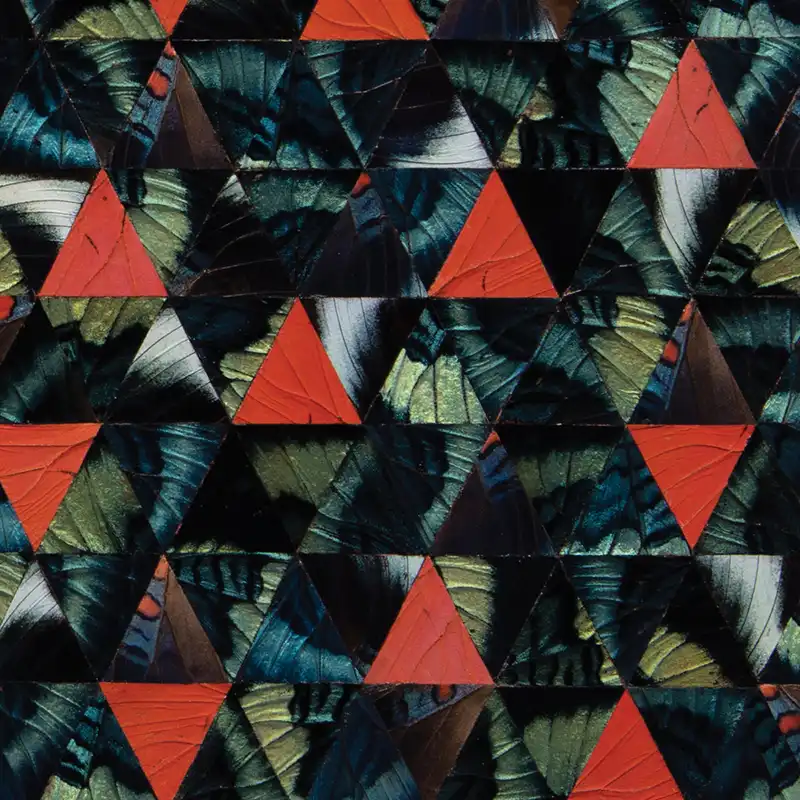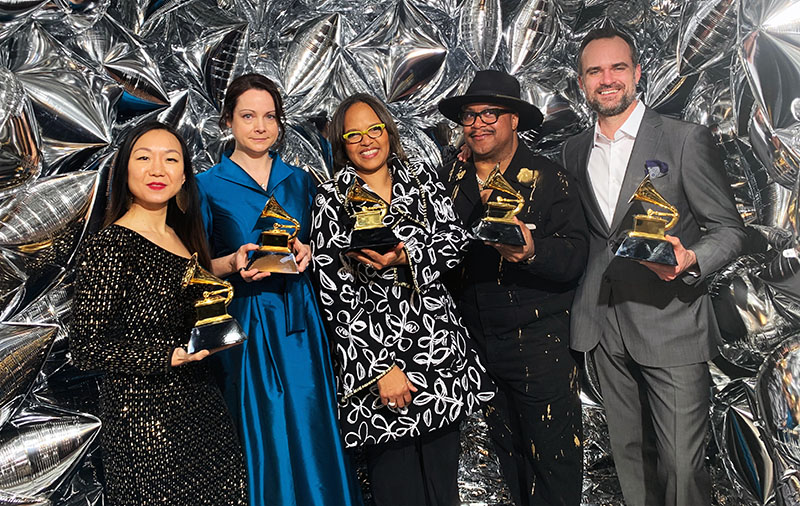Kris Davis – Of Resistance & Flight
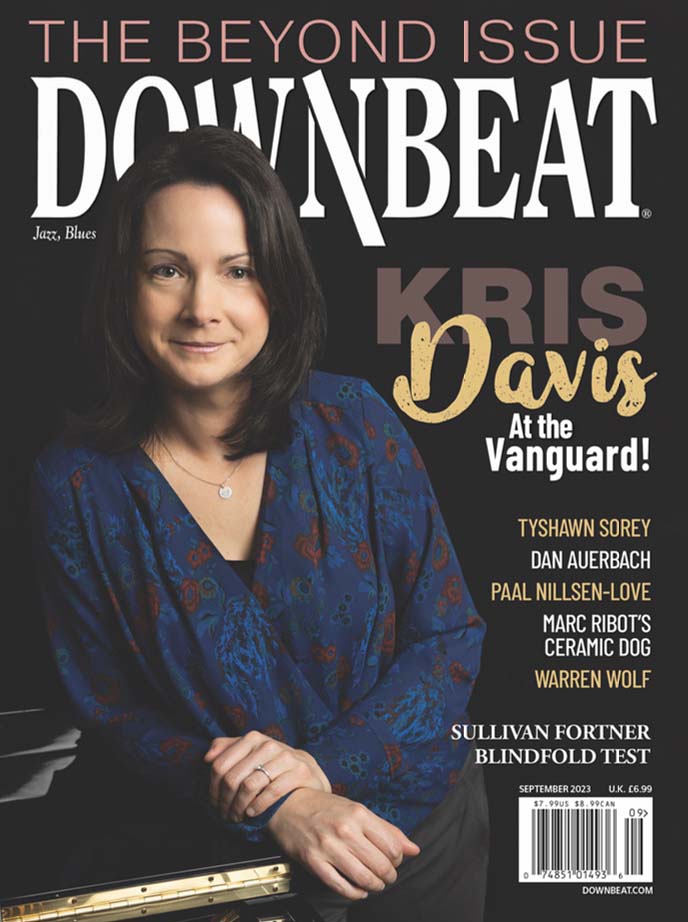
In late May 2022, Kris Davis realized a dream. She and her ensemble Diatom Ribbons performed six nights at New York’s Village Vanguard — the world’s most famous jazz venue.
The pianist, composer and bandleader originally had booked the date for April 2020, but like so many other concerts during that time, hers was canceled because of the pandemic.
In January 2021, Davis did perform at the Vanguard with drummer Eric McPherson and bassist Stephan Crump, collectively known as the Borderlands Trio. That concert gave Davis a phantasmagorical experience in getting acquainted with the club’s acoustics.
“It was sort of freaky because I’ve heard all these pianists perform at the Vanguard on albums, and suddenly I hear that sound coming back at me while I’m playing,” Davis says from her Boston home in late June, just one day away from joining Dave Holland on a European tour.
For sure, many pianists, ranging from such towering icons as Bill Evans, Bobby Timmons, McCoy Tyner and Thelonious Monk to such eminent modernists as Brad Mehldau, Uri Caine, Jason Moran, Chucho Valdés, Geri Allen and Junko Onishi have documented their stints at the Village Vanguard. And some of those albums have become part of the pantheon of best live albums in jazz history. Davis adds her scintillating new double-disc, Kris Davis’ Diatom Ribbons Live At The Village Vanguard (Pyroclastic Records), to that distinguished legacy.
Davis’ entry into the esteemed class of musicians who have chronicled their time at the Vanguard as a leader comes when her ascension in the jazz ecosystem continues to soar. Earlier this year, she became one of the first three women to win a Grammy Award for Best Jazz Instrumental Album for her contributions on New Standards Vol. 1 (Candid Records), a project produced by Terri Lyne Carrington.
Last year, DownBeat named her Pianist of the Year in its Critics Poll. A year prior to that, she received a $275,000 Doris Duke Artist Award. And in 2020, the Jazz Journalists Association named Davis both pianist and composer of the year. Since moving to New York from Toronto in the early aughts, the 43-year-old Davis has released 24 albums as a leader and co-leader, a few of which were issued on her own imprint, Pyroclastic Records.
The first Diatom Ribbons album came out in 2019. It featured a larger cast that included saxophonist JD Allen, singer and bassist esperanza splading, vibraphonist Ches Smith and guitarists Nels Cline and Marc Ribot.
For the Vanguard dates, Davis retained drummer Carrington, bassist Trevor Dunn and turntablist/sound sculptor Val Jeanty from the group’s 2019 album lineup while adding guitarist Julian Lage.
“One thing that is very cool about this group is that Kris, Val and Terri have been performing as an autonomous trio for some time, so there is a built-in core to the larger group,” Dunn says. “That makes for a certain flexibility in the configuration. Sometimes we play as a quartet; other times she might add a saxophone player, or in the case of the Vanguard record, Julian Lage. This, of course, affects the arrangements of the songs, not to mention, Kris is always coming up with new ways to approach the material.”
Spirits Up Above
Going back to the “room” sound of the Vanguard, Davis reflects on the experience of playing the piano while weighing in on the history of so many others who have performed there. Negotiating the sonic memories imprinted in the room affected some of her in-the-moment musical decisions.
“It was sort of spooky: It’s like having someone, who’s really accomplished, sit in the audience and listen to you play,” she explains, before noting that she had to put away such potentially self-sabotaging thoughts. “We had to just concentrate on what we do and stay in the moment.”
For Jeanty, the Vanguard reminds her of those cozy basement parties where DJs often spin. She started playing there in the mid-aughts. “It feels like a bar gig,” Jeanty says. “But there is so much creative energy in that space because of all of those legends, who’ve played there before.”
Lage, Diatom Ribbons newcomer, loves the room from a guitarist’s perspective. He says that it rounds out some of the edges of electric guitar and softens the attack. “For guitarists, it’s very forgiving,” he says. “There are no parallel walls in that room, so the sound functions differently than about every other space that you’ll ever play with low ceilings. The room has a lot of features that make a [concert] sound like a [studio] record.”
In turn, Dunn says that the Vanguard is “one of the driest, most unforgiving rooms” he’s ever performed in. “I can really only describe the sound as clear and direct,” Dunn says. “Somehow the room itself doesn’t interfere with the sound, which can be a positive or negative thing, depending on your perspective. For example, low subs are not amplified by a hollow stage, which is something I like in bigger rooms. As a bass player, typically positioned between the piano and drums, I have the most ideal sound in the room. At the Vanguard, it almost feels like there is an acoustic limiter happening naturally — you can’t play too loud in there; it’s not possible. Every time I’ve played there, I’ve definitely had to adjust my approach to the room. At the Vanguard there is a certain pristine quality to the sound that puts everyone under the microscope.”
Indeed, it took the ensemble some time to get its footing while striking a balance between acoustic and electric instrumentation. “You have to just live through all these sonic explorations that always go on at the Vanguard,” Dunn says. “Part of the beauty of that club is that you’re playing 12 sets over six nights. So, the invitation to go deeper into those [sonic] inquiries is far greater than when you’re playing in another room for just one night.”
Jeanty felt the challenge of the close proximity among the musicians on the small stage, especially when it came to setting up her arsenal of equipment (including a Vestax VCI-400 controller, a Roland HandSonic digital drum and a Korg Kaossilator Pro Plus). She also brought a small monitoring speaker so that she could better hear sonic collages.
“The first couple of nights, we had to adjust to all the different sounds within the band for that room,” Jeanty recalls. “The first night felt a little weird. Sometimes I would make a sound but couldn’t hear it. Other times, I would trigger a sound that was too loud. But I could feel a progression. By the third or fourth night, it was on point. It was fiyah!”
Flying Through Resistance
Diatom Ribbons Live At The Village Vanguard begins with the band’s lurking treatment of “Alice In The Congo,” a snarling harmolodic-inspired composition by drummer Roland Shannon Jackson. At the Vanguard, Dunn fattens the bottom with a lubricous undulating pulse on which Carrington helps propel with an intricate, almost New Orleans second-line groove. In between, Lage and Davis unravel crisscrossing improvisations that tighten as the rhythm section liberates from timekeeping duties and gets more involved in the collective improvisation while Jeanty joins the foil through her silvery textures.
Davis engaged in a heavy investigation of Jackson’s Decoding Society albums when she worked with David Breskin, who produced Jackson’s 1982 LP, Man Dance (Antilles), which closes with “Alice In The Congo.” Breskin had commissioned Davis and fellow pianist, Craig Taborn — collectively billed as Octopus — for a February 2022 concert at the Modern Art Museum of Fort Worth honoring Jackson. In addition to commissioning Davis and Taborn to compose two new pieces, each based upon sculptures, they performed piano-duet interpretations of “Alice In The Congo” and Jackson’s “Apache Love Cry.”
“After that [Modern Art of Museum of Fort Worth] concert, I thought ‘Alice In The Congo’ would sound cool in Diatom Ribbons,” Davis remembers before mentioning that she was listening to Jackson’s Decoding Society LPs before she recorded her first Diatom Ribbons album. “I like the groove element and the repetition element of their music, but I also like the freedom that he brings to it. I do not know if it is through his instruction or just how the musicians approached it, but there is the grounding and freedom in his music that really speaks to me.”
Later on Live At The Village Vanguard, Diatom Ribbons delivers two mesmerizing makeovers of Wayne Shorter’s “Dolores,” which was first recorded by Miles Davis’ iconic mid-’60s quintet. In concert, Davis articulates the quizzical melody across Carrington’s shu&ing momentum and Dunn’s molten bass line. As the composition progresses, Davis embroiders a stunning improvisation that stretches from the post-bop vocabulary to the thundering, dissonant edges reminiscent of Don Pullen. Eventually Lage interjects then engages Davis in some knotty cross dialogue.
Davis says that when she first started getting into jazz while growing up in the suburbs of Calgary, Canada, Miles’ mid-’60s albums featuring Shorter played a crucial role in her falling more deeply in love with the music. Decades later, she got a chance to work with him during the pandemic while he taught some of her students — via Zoom — at the Berklee College of Music’s Institute of Jazz and Gender Justice.
“[Shorter] has so many great one-liners that really rang true to me, and I reference them often,” Davis says. “One of my favorite ones was, ‘A plane needs resistance to fly.’ Man, that is so deep.”
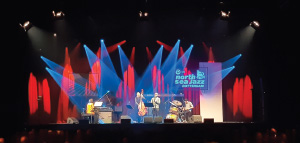
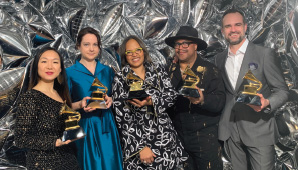
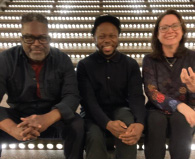
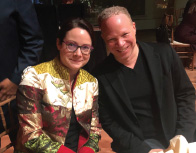
Davis as a fierce collaborator: 1. On tour with the Dave Holland New Quartet, from left, Davis, Holland, Jaleel Shaw and Nasheet Waits. 3. As a member of Trefoil with, from left, Gerald Cleaver, Ambrose Akinmusire and Davis. 3. At the Grammy Awards as member of Terri Lyne Carrington’s New Standards Vol. 1 album, which won the Grammy for Best Jazz Instrumental Album. From left, Linda May Han Oh, Davis, Carrington, Nicolas Payton and Matthew Stevens. 4. Davis with Craig Taborn, her Octopus duo partner.
Davis also pays homage to Geri Allen with the inclusion of her composition, “The Dancer,” which first appeared on Allen’s 1987 album Open On All Sides In The Middle (Minor Music). Diatom Ribbons’ version eschews Allen’s rambunctious avant-funk arrangement from the mid-’80s in favor of a more laidback, bluesier approach, marked by Davis’ plucking of the piano strings and tweaking of the Arturia microfreak synth, Lage’s languid guitar lines, Jeanty’s sandpapery textures and the rhythm section’s loping gait.
Davis says that she’d seen Allen play multiple times, but only met her once. Nevertheless, through several tribute concerts and commissions, Davis has explored Allen’s multifaceted oeuvre since her passing in 2017. When Carrington invited Davis to play at a few tribute concerts for Allen, she said that she was mostly familiar with Allen’s 1991 album, The Nurturer (Blue Note/Somethin’ Else). Eventually, Davis dug deeper and delved into Allen’s earlier repertoire such as 1984’s The Printmakers and 1985’s Homegrown (both on Minor Music).
Ghosts in the Machine
The rest of the Vanguard program consists of Davis’ suspenseful originals. Her probing “Nine Hats” almost follows Allen’s noteworthy investigations into Eric Dolphy’s music. It references Dolphy’s mid-’60s Thelonious Monk tribute, “Hat And Beard.” Davis’ composition also incorporates elements of Conlon Nancarrow’s Study No. 9 for Player Piano.
At the Vanguard, Davis maps out the swirling pointillistic melody on the synthesizer atop Lage’s lulling four-note ostinato. As she explores the inner mechanics of the acoustic piano. Dunn strums eerie acro touches on acoustic bass while Carrington and Jeanty add more intriguing colors and textures.
“Nancarrow has always been a real inspiration for me through those player piano pieces,” Davis explains. “I wanted to incorporate some of his language with Eric Dolphy’s ‘Hat And Beard.’ I just sequenced that line from ‘Hat And Beard’ in the synthesizer and used those little pieces of DNA to create an improvised piece.”
Lage’s four-note ostinato on “Nine Hats” can be detected on the conclusion of Diatom Ribbon’s treatment of “Alice In The Congo.” “I consider that [ostinato] the wallpaper of [‘Nine Hats’],” Davis says. “He was instructed not to move from that and just be this thing shimmering in the back. Then the rest of us created a soundscape around those little pieces of DNA.”
Other intrepid originals include the almost punkish “Kingfisher” — the first of the threepart suite “Bird Calls” commemorating Charlie Parker’s centennial in 2020 — on which she sublimely incorporates Olivier Messiaen’s mode three from his “modes of limited transposition.”
The episodic “Kingfisher,” however, does not sound like conventional modal jazz. Instead, it sounds like the soundtrack to a meta gaming platform. “The song is based on this idea of threes,” Davis says. “There is the three-bar cycle with the bass line happening on which a solo occurs. Then there are three sections within the bigger piece where we have that groove bass line thing, a halftime groove freak-out and then a free section. ‘Kingfisher’ incorporates this idea of jumping cuts between sections.”
Messiaen’s influence also manifests in the evocative second part of the suite, “Bird Call Blues,” a capricious original that wouldn’t sound out of place on one of Art of Noise’s seminal ’80s albums thanks to Jeanty’s virtuosic turntablism and sonic manipulations of voiceovers from Messiaen and Paul Bley. Diatom Ribbons also utilizes voiceover samples of Sun Ra from a 1991 radio interview on the protean “VW” and Karlheinz Stockhausen from a 1972 lecture on the riveting third part of the suite, “Parasitic Hunter.”
“Val is the X factor for me,” says Davis, before revealing that prior to them working together that she had not written or played with a turntablist. “When we first improvised, she was using her banks of sounds and audio clippings of interviews. As we got further into the process of the [2019] album, I thought it would be really nice to bring in some clips of interviews of people that I really respect. Cecil Taylor had just passed away, and I was looking for a way to pay tribute with a different approach to paying tribute to him.”
“I just stared digging around and finding language that Val could use that felt personal to me in the music,” Davis continues. “Then she could manipulate in any way that she felt would work. I like to give her some sonic tools, but then tell her that she can do whatever with them.”
Jeanty says that Davis provided charts for all of the compositions. On some songs, Davis notated specific voices in sections. “But Kris doesn’t say that it has to come on the fourth bar or something like that,” Jeanty explains. “We let the samples flow into the music naturally. We have a trust. There are specific instructions in other places where she will notate that certain sounds need to occur in the intro. For instance, on ‘Bird Call Blues,’ Davis specified that she wanted the song to begin with samples of bird’s chirping. But it was up to me on how I wanted to scratch with those sounds.”
Groove Allegiance
Davis formed Diatom Ribbons to channel her love for groove-based music. She said that her compositions from prior albums before the ensemble’s 2019 outing lacked a strong foundational groove. But before Diatom Ribbons was established, Davis began working with Carrington and Jeanty. Carrington told Davis that she was attracted to her strong sense of rhythm combined with her strong sense of freedom.
“It was exactly what I was looking for some years back when we first connected,” Carrington says. “[Kris] is a beast of a player with incredible technique, but most importantly to me is the sound she gets out of the piano. And she’s always looking for windows for ways out. The expansion in harmony from the written material of the compositions allows expansion in rhythm. They go hand in hand. I love playing with her because I don’t feel trapped.”
In turn, Davis praises Carrington for her improvisational acumen and keen listening skills. The pianist also agrees that the two have a strong rhythmic connection. “I love playing improvised music with drummers who have a real sense of groove as well as time and rhythm, because then I can get more into the exploratory state. Sometimes, when I play with drummers that are more color-oriented, who never go into a groove or even provide colors through rhythm, something is lost for me.”
In describing Davis’ compositions for Diatom Ribbons, Carrington notes that they are not freeform in spite of their capacious sound. “They are extremely intricate and most of them are notated profusely so you have to be a good reader,” Carrington explains. “The challenge with her music is to play the written material and make them sound free. When people see a lot of notes on paper, they often see it as confinement, but with her music it all makes such beautiful sense.”
Lage says Davis’ compositions are a great invitation for guitarists in how they deal with frequencies and a wide sonic spectrum. “She designs these pieces where you really can’t go wrong,” he says. “As a guitarist, it never feels like, ‘Oh, God, if I don’t do the right thing, I’m not going to fit in.’ A true hallmark of her music is that it transcends instrumentation.”
“Kris’ music has everything — vamps, openness, changes, melodies,” Dunn adds. “There are dense harmonies as well as sparse ones that give way to interpretation. As a bassist, every tune is a new adventure.’ I jump back and forth between upright and electric basses, swinging over changes or holding down atonal ostinatos. In many ways it is the ideal band for me.”’
“The thing that came to me through the Vanguard concerts as well as from the first Diatom Ribbons album is Wayne’s idea about needing resistance to fly,” Davis says. “There is something about writing tunes that are more tonal that gives me the space to be more exploratory in terms of my musical language and intervallic approach as an improviser. It also allows me to use more atonal language to create that resistance to fly.”

